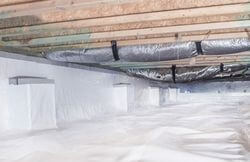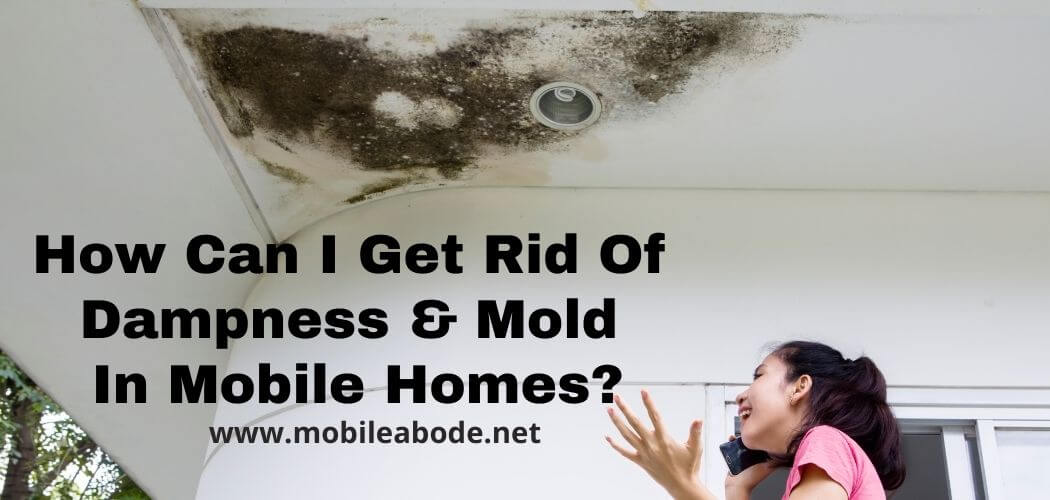If you are living in a mobile home, your house is likely constructed of plastic. This means that it can be more difficult to keep dry and mold-free than if the mobile home were made of wood.
We’re here to help you solve your dampness and mold problems. We’ll provide you with all the information you need on how to get rid of these nuisances in your mobile home.
You will be able to find out more about the causes, symptoms, prevention methods, treatment options, and possible consequences of dampness and mold growth.
We also have resources for homeowners who are interested in learning more about what they can do to keep their homes free from this problem.
If we don’t answer any questions for you within our blog post or any other posts on our site please feel free to contact us so that we may assist you further!
Related Article: 5 Steps To Insulate Under A Mobile Home
Steps to Getting Rid Of Dampness & Mold in Mobile Home
There are many ways to get rid of dampness and mold in your mobile home.
But before you do anything else, make sure you know why there’s moisture building up inside the walls – this will help you decide on how best to fix the problem.
Step 1: The first step you should take in solving any mold or dampness problems in your mobile home is to check the exterior of your house and look for water buildup at the base of it.
If there is a lot of rain and snow near where your home is, then the ground will be wet and cause moisture around your walls that can lead to the growth of mold and mildew.
You can easily solve this by checking underneath your mobile home for standing water/moisture; once found it should be dried out thoroughly before you try to go any further with other methods to get rid of dampness and mold under a mobile home.
Step 2: The next thing you want to do when trying to remove dampness and mold from inside a mobile home is to check the inside of your house.
You should either do this by walking around and knocking on the different sheet metal panels that make up a mobile home, or take a look at the flooring and see if there are any spots where it looks particularly damp – usually you’ll find this at corners, underneath furniture, etc.
Once you have identified a problem area then cut an X into that section of sheet metal with a knife to allow ventilation inside the wall cavity.
This will help dry out mold and also prevent further accumulation of moisture in these areas which could easily start forming again if not dried out properly.
Step 3: The third step is checking for water leaks from the outside. Sometimes your roof might have a leak in it and rainwater can drip down the wall of your mobile home, leading to the growth of mold inside.
To check for this you can either look at your roof or feel around all over where it meets the walls of your house to see if any damp spots might indicate a leak.
The best way to solve this problem is either by finding and fixing the source of water coming in (e.g. getting rid of an ice dam) or installing flashing tape between the exterior walls and rooftops; doing these things will prevent water build-up which prevents mold growth.
Step 4: The fourth step involves you doing some work to seal up any leaks in your mobile home that could be letting water seep through the walls and roof, thereby leading to the growth of mold inside.
This applies especially if it was previously raining/snowing heavily outside when the dampness started appearing; if so then look for obvious signs of leaks like dark patches on ceilings/walls, brown stains on insulation.
Step 5: Please note that if your house already has black mold growing inside, don’t try using bleach to clean up the problem as bleach will only make the situation worse!
You should instead either use a special anti-mold agent or take all of your furniture out and bleached everything until it’s completely free from mold.
Recurrence Prevention: After you’ve finished cleaning it’s important to repair any leaks you find and plug up any openings that might lead to water build-up (e.g. cracks in windows/doors, etc.) as these are inevitable problems that will continue to occur over time – so the only way to prevent mold from coming back is by making sure everything’s sealed properly!
Step 6: The sixth step involves checking around your mobile home for any signs of dampness and moisture every once in a while before it becomes a serious problem and if you do notice anything then take action immediately to fix it or cut holes into those areas with a knife as shown earlier before it starts growing into black mold again.
Step 7: And lastly, try to keep humidity levels as low as possible inside your mobile home as this will prevent mold from growing easily.
One way of doing this is by using a dehumidifier which sucks up all the moisture in the air, thereby greatly reducing humidity levels.
That’s it! If you follow these steps properly then almost any kind of mold problem should be able to be fixed without too much difficulty or having to spend lots of money on expensive repair work/products.
Related Article: How To Deodorize A Mobile Home?
How to Dry Out Under a Mobile Home?

The best way to dry out a mobile home is to make sure the water has been turned off and remove any standing water.
The next step would be to use fans, dehumidifiers, or air movers that are designed for this purpose.
Trying to dry out under a mobile home can be tough.
There are many different products on the market that claim they will help you do this, but I wanted to tell you about my experience with one of them in particular. This product is called Damp Rid Moisture Absorber and it does work!
After using it for three months, my problem was solved. I highly recommend giving it a try if you have similar problems as me!
Final Words:-
If you are experiencing mold or dampness in your home, it is important to act quickly. The longer these problems go untreated the more difficult they can be to eradicate and the risk of health complications may increase over time.
Mold spores produce allergens that can cause respiratory problems like asthma which could lead to greater medical expenses down the line if not treated soon enough. And be sure to read labels carefully before buying any product or service as not all solutions will work on all problems.
You may also want to contact professionals who specialize in this area such as an indoor air quality specialist near me if you have more questions about how best to solve these issues.

